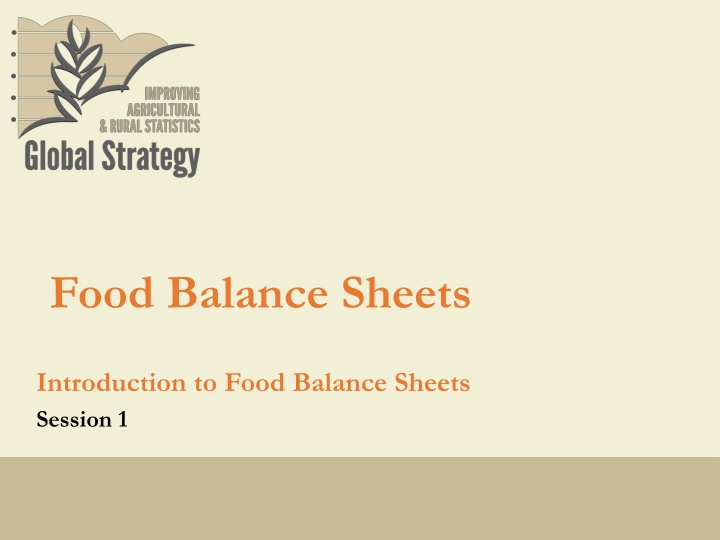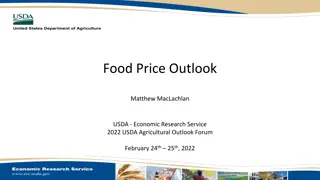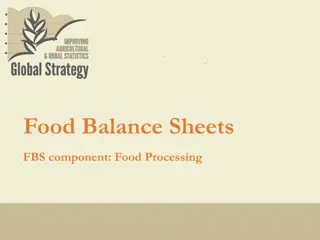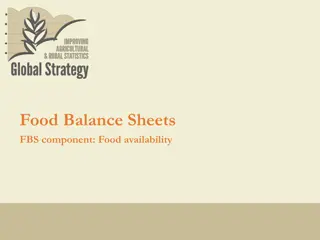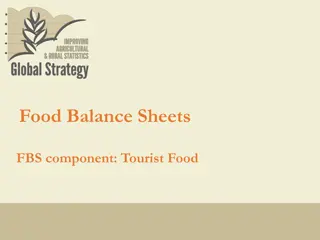Introduction to Food Balance Sheets: Historical Background and Framework
Explore the historical background and framework of Food Balance Sheets (FBS) in this session. Learn about the SUA/FBS equation, potential uses of FBS, caution in interpreting estimates, and fundamental principles of FBS construction. Discover how FBS has evolved since its inception during World War I, from international comparisons to modern methodologies.
Download Presentation

Please find below an Image/Link to download the presentation.
The content on the website is provided AS IS for your information and personal use only. It may not be sold, licensed, or shared on other websites without obtaining consent from the author.If you encounter any issues during the download, it is possible that the publisher has removed the file from their server.
You are allowed to download the files provided on this website for personal or commercial use, subject to the condition that they are used lawfully. All files are the property of their respective owners.
The content on the website is provided AS IS for your information and personal use only. It may not be sold, licensed, or shared on other websites without obtaining consent from the author.
E N D
Presentation Transcript
Food Balance Sheets Introduction to Food Balance Sheets Session 1
Learning objective At the end of this session, the participants will: a) Know the historical background of the FBS framework b) Understand the basic SUA/FBS equation c) Be informed about some of the potential uses of FBS d) Be aware of the major caution on FBS interpretation and of the fundamental principles of FBS construction 2 2
Outline 1. History 2. Definition of SUA and FBS 3. Potential Uses 4. Caution in interpreting FBS estimates 5. Fundamental principles of FBS construction 3 3
1. History World War I: first attempts at preparing FBS 1936: preparation of a systematic international comparison of food consumption data (requested by the League of Nations Mixed Committee on the Problem of Nutrition - Sub- Committee on Nutritional Statistics) 1942-43: 1stintensive use of FBS to analyze the food security situation after the World War II 1948: FAO Conference encouraged governments to develop their own FBS with FAO assistance 4 4
1. History 1949: printing of the Handbook for the Preparation of Food Balance Sheets o FBS were published for 41 countries and since then it s regularly prepared and published 1957: for methodological reasons, it was decided to publish three-year average FBS (instead of annual) 1977: food balance sheets for 162 countries o table of per caput food supplies showed [cal., prot., fat] the supply by food groups of selected minerals and vitamins 5 5
1. History 2015: intensive focus of finalizing the revised FBS methodology. Same overall framework, but important innovations. Main changes: a) Updating the overall approach solve the balance (more refined) b) Updating/refining the imputation methods of the FBS components harness links between the various FBS variables/elements and information from outside the FBS e.g. the new feed use imputation method (animal number, type of breeding ) c) More accuracy with the various variables e.g. other utilization tourist food, other utilizations d) Less discretion of the compiler e) International classifications adopted (FCL replaced by CPC and HS) 6 6
2. Definition of SUA and FBS The FBS is a national accounting/statistical framework, presenting a comprehensive picture of the pattern of a country's food supply during a specified reference period. SUPPLY = UTILIZATION P + I - dSt = X + Fo + Fe + Se + T + IU + Lo + ROU + food processing Where: P = production I = imports dSt = stocks Fo = food Fe = feed Fe = feed Se= seed T= tourist food IU= industrial Use Lo= Loss Rou= Residual or other uses 7 7
2. Definition of SUA and FBS FBSs are derived from the SUAs SUA : Supply Utilization Account The balance is compiled for every food item consumed within a country SUA Validation & Balancing Commodities are converted in their primary commodity equivalent and aggregated stand. Validation & Balancing Primary commodity equivalent balances are combined in to one FBS FBS 8 8
2. Definition of SUA and FBS Population Per capita: Quantity Food Dietary Energy Supply (DES) Calories component Proteins Fats Food conversion factors 9 9
2. Definition of SUA and FBS The SUA/FBS is an analytical dataset that : shows the sources of supply and its utilization for each food item; provides the availability for human consumption; shows the changes in the types of food consumed. 11 11
2. Definition of SUA and FBS The two pillars of the SUA/FBS: 1. Production data (Annual production Questionnaire) 2. Trade data (COMTRADE) Link on the FAOSTAT webpage: http://www.fao.org/faostat/en/#home 12 12
3. Potential Uses Basis for policy analysis aimed at ensuring food security: o Estimate the food shortages/surpluses o Estimate the amount of food aid o Estimate a country s overall DES and macronutrient availability (proxy of food consumption) o Determine the availability of a certain class of food o Analyze livestock policies (e.g. the degree to which primary food resources are used to produce animal feed) 13 13
3. Potential Uses Calculation of derived indicators: oPrevalence of Undernourishment (PoU) oSelf-sufficiency ratio (SSR) Production SSR = Production + Imports Exports + Stock oImport dependency ratio (IDR) Imports IDR = Production + Imports -Exports + Stock 14 14
3. Potential Uses Statistical proposes: oFramework for data reconciliation ( sources) oHarmonization of data collection efforts oData validation (supply and demand picture) - validate the national statistics oImprove National Account estimates (through the agricultural production measurement/estimation) 15 15
3. Potential Uses oMeans of comparing food availability (from FBS) and food consumption (from HH surveys) e.g. to cross-check the data on food consumption (and vice versa) e.g. as a proxy of food consumption in the absence of data. 16 16
3. Potential Uses Other potential uses: o Benchmarking (compare food availability across countries) o Comparing food availability over time o Track changes in dietary composition & growth of consumption in new products o Determine how prices affect food availability o Link to two SDG indicators (2.1.1 & 12.3.1) 17 17
4. Caution in interpreting FBS estimates " Food availability", not "food consumption" o DES is likely to overestimate the amount of food actually consumed FBS food availability takes into accounts all consumption within a country (HH, schools, hospitals .) Average of food/nutrient availability (distribution among different groups of people is not considered) 18 18
4. Caution in interpreting FBS estimates Commodity Balances FBS FBS : only food-related commodities (e.g. rubber is not included) FBS : the quantity estimates of food must be reported in their caloric equivalent FBS : contains aggregated estimates of both a primary commodity and all of its derived products (expressed at the primary commodity equivalent level) o many countries produce commodity balances for primary products, but do not account for goods derived from those primary products underestimate total consumption 19 19
5. Fundamental principles of FBS construction Three basic principles to ensure that country-level FBS are (i) reproducible, (ii) coherent, and (iii) transparent: a) Measurement first Countries should invest in improving measurement of input data. b) Document data and process compilers should document data sources, applied methodologies and solutions to identified data inconsistencies c) Feedback and collaboration Validation by multiple actors Opportunity to improve input data 20 20
Conclusions of the 1stchapter In this chapter we learned the general concepts of SUA and FBS : Their potential uses Some notes on FBS interpretation The 3 fundamental principles of FBS compilation 21 21
Reference 1stchapter of the Guidelines: Introduction From page 9 to page 17 22 22
